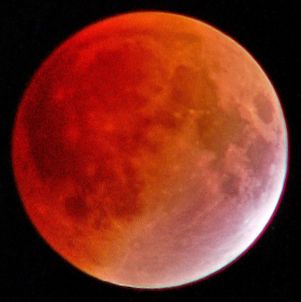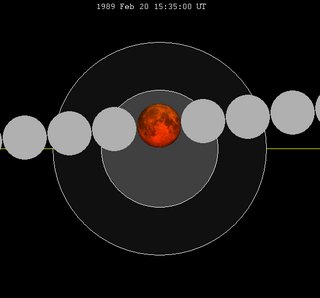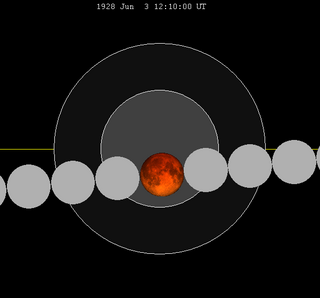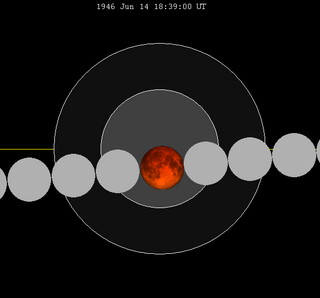
A total lunar eclipse will take place on September 8, 2090.
Contents
This is the final (last) total lunar eclipse of Lunar Saros 129. The next 21 eclipses are all partial events, starting with the September 20, 2108 partial lunar eclipse.

A total lunar eclipse will take place on September 8, 2090.
This is the final (last) total lunar eclipse of Lunar Saros 129. The next 21 eclipses are all partial events, starting with the September 20, 2108 partial lunar eclipse.
It will be completely visible over Americas, Europe, Africa, Asia and Australia, seen rising over the Americas on the evening of Friday, September 8, 2090 and setting over Asia and Australia on the morning of Saturday, September 9, 2090.
Lunar saros series 129, repeating every 18 years and 11 days, containing 71 events, has 11 total lunar eclipses. The first total lunar eclipse of this series was on May 24, 1910, and last will be on September 8, 2090. The longest occurrence of this series was on July 16, 2000 when totality lasted 106 minutes and 24.6 seconds.
| Greatest | First | |||
|---|---|---|---|---|
 The greatest eclipse of the series occurred on 2000 Jul 16, lasting 106 minutes. | Penumbral | Partial | Total | Central |
| 1351 Jun 10 | 1513 Sep 15 | 1910 May 24 | 1946 Jun 14 | |
| Last | ||||
| Central | Total | Partial | Penumbral | |
| 2036 Aug 7 | 2090 Sep 8 | 2469 Apr 26 | 2613 Jul 24 | |
| 1910 May 24 | 1928 Jun 3 | 1946 Jun 14 | |||
 |  |  |  |  |  |
| 1964 Jun 25 | 1982 Jul 6 | 2000 Jul 16 | |||
 |  |  |  |  |  |
| 2018 Jul 27 | 2036 Aug 7 | 2054 Aug 18 | |||
 |  |  |  |  |  |
| 2072 Aug 28 | 2090 Sep 8 | ||||
 |  |  |  | ||
It last occurred on August 18, 2054 and will next occur on September 20, 2108.
This is the 42nd member of Lunar Saros 129, and the last total eclipse. The previous event is the August 2072 lunar eclipse. Lunar Saros 129 contains 11 total lunar eclipses between 1910 and 2090. Solar Saros 136 interleaves with this lunar saros with an event occurring every 9 years 5 days alternating between each saros series.
A lunar eclipse will be preceded and followed by solar eclipses by 9 years and 5.5 days (a half saros). [1] This lunar eclipse is related to two total solar eclipses of Solar Saros 136.
| September 3, 2081 | September 14, 2099 |
|---|---|
 |  |

A total lunar eclipse occurred on 28 August 2007, lasting just over 90 minutes. The Moon entered the Earth's penumbra at 7:53:40 UTC. The first partial phase began in earnest at 8:51:16 UTC when the Moon entered the Earth's umbra. It exited the penumbra at 13:20:57 UTC.

A total lunar eclipse took place on Sunday 16 July 2000, the second of two total lunar eclipses in 2000.

A total lunar eclipse took place on Monday, February 20, 1989, the first of two total lunar eclipses in 1989.

A total lunar eclipse will take place on August 7, 2036. The southern tip of the Moon will pass through the center of the Earth's shadow. This is the last central lunar eclipse of Saros cycle 129.

A total lunar eclipse occurred at the Moon's descending node on 27 July 2018. The Moon passed through the center of Earth's shadow in what was the first central lunar eclipse since 15 June 2011. It was also the second total lunar eclipse in 2018, after the one on 31 January. It was the longest total lunar eclipse of the 21st century, but not the longest in the 3rd millennium. The longest total lunar eclipse of the 3rd millennium will occur on May 12, 2264, lasting 106 minutes and 13.2 seconds, which will be the longest total lunar eclipse since 2000, and the longest one until 3107.
A total lunar eclipse took place on Tuesday, July 6, 1982, the second of three total lunar eclipses in 1982, and the only one that was in the descending node. A dramatic total eclipse lasting 1 hour and 46 minutes plunged the full Moon into deep darkness, as it passed right through the centre of the Earth's umbral shadow. While the visual effect of a total eclipse is variable, the Moon may have been stained a deep orange or red colour at maximum eclipse. This was a great spectacle for everyone who saw it. The partial eclipse lasted for 3 hours and 56 minutes in total.
A total lunar eclipse took place on Friday, August 6, 1971, the second of two total lunar eclipses in 1971. A dramatic total eclipse lasting 1 hour, 39 minutes and 24.8 seconds plunged the full Moon into deep darkness, as it passed right through the centre of the Earth's umbral shadow. While the visual effect of a total eclipse is variable, the Moon may have been stained a deep orange or red colour at maximum eclipse. This was a great spectacle for everyone who saw it. The partial eclipse lasted for 3 hours, 35 minutes and 31.9 seconds in total. Occurring only 2.2 days before perigee, the Moon's apparent diameter was 3.6% larger than average and the moon passed through the center of the Earth's shadow.

A total lunar eclipse took place on Thursday, June 25, 1964. The Moon passed through the center of the Earth's shadow.
A total lunar eclipse took place on Thursday, April 24, 1986, the first of two total lunar eclipses in 1986, the second being on October 17, 1986. The Moon was plunged into darkness for 1 hour, 3 minutes and 34.8 seconds, in a deep total eclipse which saw the Moon 20.217% of its diameter inside the Earth's umbral shadow. The visual effect of this depends on the state of the Earth's atmosphere, but the Moon may have been stained a deep red colour. The partial eclipse lasted for 3 hours, 18 minutes and 46.8 seconds in total. The Moon was just 1.2 days before perigee, making it 5.3% larger than average.

A total lunar eclipse will take place on 7-8 September 2025. The Moon will barely miss the center of the Earth's shadow. It will be the second of two total lunar eclipses. Occurring roughly 3 days before perigee, the Moon will appear larger than usual.
A total lunar eclipse took place on Saturday, September 16, 1978, the second of two total lunar eclipses in 1978. The Moon was plunged into darkness for 1 hour, 18 minutes and 39 seconds, in a deep total eclipse which saw the Moon 32.683% of its diameter inside the Earth's umbral shadow. The visual effect of this depends on the state of the Earth's atmosphere, but the Moon may have been stained a deep red colour. The partial eclipse lasted for 3 hours, 27 minutes and 11.6 seconds in total.

A total lunar eclipse will take place on June 17, 2076. The moon will pass through the center of the Earth's shadow. While the visual effect of a total eclipse is variable, the Moon may be stained a deep orange or red color at maximum eclipse. With a gamma value of only −0.0452 and an umbral eclipse magnitude of 1.7943, this is the second greatest eclipse in Saros series 131 as well as the largest and darkest lunar eclipse between June 26, 2029 and June 28, 2094. Overall, it will be the third largest and darkest lunar eclipse of the 21st century. While it will have similar values to the lunar eclipse of July 16, 2000, totality will not last over 106 minutes due to the moon's relatively large apparent size as seen from Earth and greater speed in its elliptical orbit. Totality's expected to last 100 minutes 34 seconds from 9:11:39 to 10:52:15 with the greatest point at 10:01:57 UTC.

A total lunar eclipse took place on Wednesday, October 18, 1967, the second of two total lunar eclipses in 1967, the first being on April 24, 1967.
A total lunar eclipse took place at the Moon's descending node of the orbit on Tuesday, May 24, 1910 with an umbral eclipse magnitude of 1.09503. A total lunar eclipse takes place when the Earth comes between the Sun and the Moon and its shadow covers the Moon. Eclipse watchers can see the Moon turn red when the eclipse reaches totality. Total eclipses of the Moon happen at Full Moon when the Sun, Earth, and Moon are aligned to form a line. The astronomical term for this type of alignment is syzygy, which comes from the Greek word for being paired together. The Moon does not have its own light but shines because its surface reflects the Sun's rays. During a total lunar eclipse, the Earth comes between the Sun and the Moon and blocks any direct sunlight from reaching the Moon. The Sun casts the Earth's shadow on the Moon's surface. A shallow total eclipse saw the Moon in relative darkness for 49 minutes and 29.5 seconds. The Moon was 9.503% of its diameter into the Earth's umbral shadow, and should have been significantly darkened. The partial eclipse lasted for 3 hours, 35 minutes and 22.9 seconds in total.

A total lunar eclipse took place on Sunday, June 3, 1928.

A total lunar eclipse took place on Friday, June 14, 1946. The northern tip of the moon passed through the center of the Earth's shadow. This was the first central lunar eclipse of Saros series 129.

A total lunar eclipse will take place on August 18, 2054.

A total lunar eclipse will take place on August 28, 2072.

Saros cycle series 136 for solar eclipses occurs at the Moon's descending node, repeating every 18 years, 11 days, containing 71 events. All eclipses in this series occurs at the Moon's descending node.

Saros cycle series 129 for lunar eclipses occurs at the moon's descending node, repeats every 18 years 11+1/3 days. The 129th lunar saros is associated with Solar Saros 136.